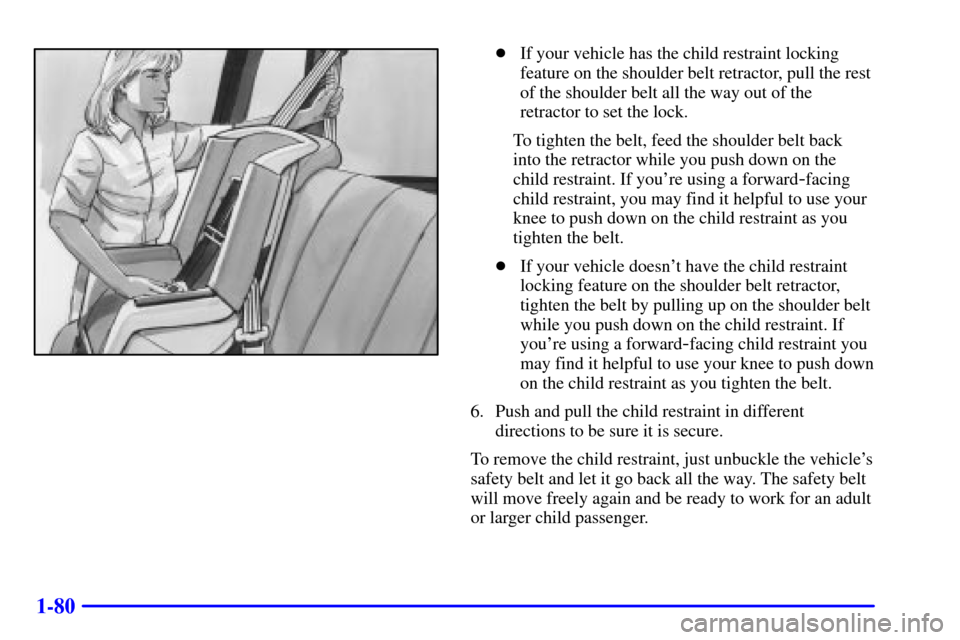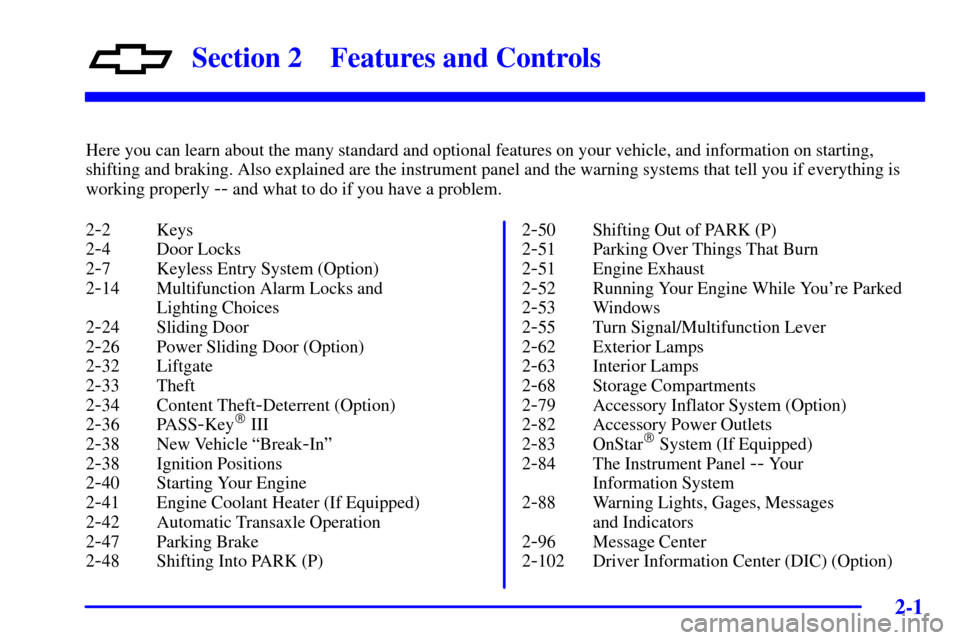Page 60 of 429
1-48
2. Push the latch plate into the buckle until it clicks.
Second Row Outside Passenger Positions
Third Row Outside Passenger Positions
If the belt stops before it reaches the buckle, tilt the
latch plate and keep pulling until you can buckle it.
Pull up on the latch plate to make sure it is secure.
On some vehicles, when the shoulder belt is pulled
out all the way, it will lock. If it does, let it go back
all the way and start again. If the belt is not long
enough, see ªSafety Belt Extenderº at the end of this
section. Make sure the release button on the buckle is
positioned so you would be able to unbuckle the
safety belt quickly if you ever had to.
Page 61 of 429
1-49
3. To make the lap part tight, pull down on the buckle
end of the belt as you pull up on the shoulder part.The lap part of the belt should be worn low and snug on
the hips, just touching the thighs. In a crash, this applies
force to the strong pelvic bones. And you'd be less likely
to slide under the lap belt. If you slid under it, the belt
would apply force at your abdomen. This could cause
serious or even fatal injuries. The shoulder belt should go
over the shoulder and across the chest. These parts of the
body are best able to take belt restraining forces.
The safety belt locks if there's a sudden stop or a crash,
or if you pull the belt very quickly out of the retractor.
Page 91 of 429
1-79
4. Buckle the belt. Make sure the release button is
positioned so you would be able to unbuckle the
safety belt quickly if you ever had to.5. Some vehicles have a child restraint locking feature
on the shoulder belt retractor. You can tell if your
vehicle has this feature by pulling the shoulder belt
all the way out of the retractor. Then, let the belt go
back a few inches, and try to pull the belt out again.
If you can't pull the belt out because it has locked,
it means the retractor has the child restraint locking
feature. If the belt doesn't lock and you can pull the
belt out of the retractor again, it means your vehicle
doesn't have the child restraint locking feature on the
shoulder belt retractor.
Page 92 of 429

1-80
�If your vehicle has the child restraint locking
feature on the shoulder belt retractor, pull the rest
of the shoulder belt all the way out of the
retractor to set the lock.
To tighten the belt, feed the shoulder belt back
into the retractor while you push down on the
child restraint. If you're using a forward
-facing
child restraint, you may find it helpful to use your
knee to push down on the child restraint as you
tighten the belt.
�If your vehicle doesn't have the child restraint
locking feature on the shoulder belt retractor,
tighten the belt by pulling up on the shoulder belt
while you push down on the child restraint. If
you're using a forward
-facing child restraint you
may find it helpful to use your knee to push down
on the child restraint as you tighten the belt.
6. Push and pull the child restraint in different
directions to be sure it is secure.
To remove the child restraint, just unbuckle the vehicle's
safety belt and let it go back all the way. The safety belt
will move freely again and be ready to work for an adult
or larger child passenger.
Page 99 of 429
1-87
6. Some vehicles have a child restraint locking feature
on the shoulder belt retractor. You can tell if your
vehicle has this feature by pulling the shoulder belt
all the way out of the retractor. Then, let the belt go
back a few inches, and try to pull the belt out again.
If you can't pull the belt out because it has locked,
it means the retractor has the child restraint locking
feature. If the belt doesn't lock and you can pull the
belt out of the retractor again, it means your vehicle
doesn't have the child restraint locking feature on the
shoulder belt retractor.�If your vehicle has the child restraint locking
feature on the shoulder belt retractor, pull the rest
of the shoulder belt all the way out of the
retractor to set the lock.
To tighten the belt, feed the shoulder belt back
into the retractor while you push down on the
child restraint. You may find it helpful to use your
knee to push down on the child restraint as you
tighten the belt.
Page 100 of 429
1-88
�If your vehicle doesn't have the child restraint
locking feature on the shoulder belt retractor,
tighten the belt by pulling up on the shoulder belt
while you push down on the child restraint. You
may find it helpful to use your knee to push down
on the child restraint as you tighten the belt.
7. Push and pull the child restraint in different
directions to be sure it is secure.
To remove the child restraint, just unbuckle the vehicle's
safety belt and let it go back all the way. The safety belt
will move freely again and be ready to work for an adult
or larger child passenger.Larger Children
Children who have outgrown child restraints should
wear the vehicle's safety belts.
If you have the choice, a child should sit next to a
window so the child can wear a lap
-shoulder belt and
get the additional restraint a shoulder belt can provide.
Page 105 of 429

2-
2-1
Section 2 Features and Controls
Here you can learn about the many standard and optional features on your vehicle, and information on starting,
shifting and braking. Also explained are the instrument panel and the warning systems that tell you if everything is
working properly
-- and what to do if you have a problem.
2
-2 Keys
2
-4 Door Locks
2
-7 Keyless Entry System (Option)
2
-14 Multifunction Alarm Locks and
Lighting Choices
2
-24 Sliding Door
2
-26 Power Sliding Door (Option)
2
-32 Liftgate
2
-33 Theft
2
-34 Content Theft-Deterrent (Option)
2
-36 PASS-Key� III
2
-38 New Vehicle ªBreak-Inº
2
-38 Ignition Positions
2
-40 Starting Your Engine
2
-41 Engine Coolant Heater (If Equipped)
2
-42 Automatic Transaxle Operation
2
-47 Parking Brake
2
-48 Shifting Into PARK (P)2
-50 Shifting Out of PARK (P)
2
-51 Parking Over Things That Burn
2
-51 Engine Exhaust
2
-52 Running Your Engine While You're Parked
2
-53 Windows
2
-55 Turn Signal/Multifunction Lever
2
-62 Exterior Lamps
2
-63 Interior Lamps
2
-68 Storage Compartments
2
-79 Accessory Inflator System (Option)
2
-82 Accessory Power Outlets
2
-83 OnStar� System (If Equipped)
2
-84 The Instrument Panel -- Your
Information System
2
-88 Warning Lights, Gages, Messages
and Indicators
2
-96 Message Center
2
-102 Driver Information Center (DIC) (Option)
Page 107 of 429
2-3
The master key can be
used for the ignition as
well as all door locks, the
liftgate lock and the
storage compartments.
If you need a new key, contact your Chevrolet dealer,
who can obtain the correct key code. In an emergency,
call Chevrolet Roadside Assistance at
1
-800-CHEV-USA� (1-800-243-8872).
(In Canada, call 1
-800-268-6800.)
NOTICE:
Your vehicle has a number of new features that
can help prevent theft. But you can have a lot of
trouble getting into your vehicle if you ever lock
your key inside. You may even have to damage
your vehicle to get in. So be sure you have an
extra key.